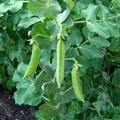
The pea, Pisum sativum, is a Fabaceae family annual herbaceous legume farmed for its edible seeds and seedpods. The pea plant has thin stems that use tendrils to cling to a surface and can be bushy or climbing. Each leaf contains 1-3 pairs of oblong leaflets that can range in length from 1-6 cm. The plant produces swollen or compressed green seedpods that can be straight or curved, as well as white, red, or purple flowers. The pea, which is also known as the garden pea, English pea, or green pea, probably originated in Southwest Asia.
Lists of Diseases and Pests Affecting Sweet Peas
Anthracnose (Glomerella cingulata)
White lesions on leaves, stems, and flower stalks are the earliest signs of the disease. Severe infection causes a significant loss of leaves, and the tips of the shoots may wilt and die. After rainy spells, infected tissues usually develop crimson spore masses. The fungus that causes apples to decay bitterly is the same one.
It is beneficial to make an effort to increase plant vigor by fertilizing and watering. To give the leaves time to dry before nightfall, watering should be done early in the day. Picking and removing symptomatic leaves as soon as they appear and after the tops have been damaged by frost is also beneficial. Additionally, utilizing healthy seeds and growing in clean soil might help avoid this illness.
Applications of fungicides can be done as new growth appears in the spring; however, they are often not required. Maneb and thiophanate-methyl are two of the substances that have been approved for usage. For dose guidelines and safety considerations, refer to the label.
Root rot (Rhizoctonia solani)
The overall withering, decline, and collapse of the leaves and the entire plant are among the broad, non-specific signs of this illness that can be seen above ground. Browning and rotting of the roots and the crown are frequently seen in addition to this overall droopiness or flaccid look. On the main stem, lesions that are dark or discoloured might appear close to the soil line. The outer leaves start to yellow and die, and eventually, the entire plant dies.
Once plants are infected, control can be challenging, therefore prevention is crucial. Avoiding both overwatering and watering the plant's crown directly is beneficial, especially in thick soils. Plants with severe symptoms can be rogued and removed because full recovery is improbable.
Powdery mildew
On leaves and occasionally on stems, white powdery specks or patches appear. The symptoms are typically more noticeable in hot, humid conditions and frequently initially occur on the upper surfaces of the leaves. heavily affected leaves shrivel and turn brown.
By keeping plants from being too close together and by carefully removing the sick leaves as soon as symptoms appear, the disease can be reduced. To prevent the fungus' spores from infecting neighboring plants, symptomatic leaves can be put into a plastic bag. Fungicide use is typically unnecessary. Applications, however, can be made as soon as symptoms become apparent.
Spotted wilt (virus)
The first signs of an infection are the mottling of the leaves. These leaves and stems subsequently start to acquire purple dots. The western flower thrips is the carrier of this virus.
Given that plants cannot be healed once they have contracted this disease, control of it is centered on prevention. Since this virus has a very wide host range, it is crucial to get rid of and remove infected plants as soon as they are identified, as well as other symptomatic plants. The management of the thrips population is also essential.
Aphids
The potato aphid can occasionally infest sweet peas, although the pea aphid is the more prevalent. This pest can be controlled by spraying with insecticidal soap, ultrafine horticultural oil, or malathion, three substances that are registered in Connecticut for the management of this pest. Imidacloprid could also be helpful as a systemic that the roots can absorb. For dose guidelines and safety considerations, refer to the label.
Pea weevils
In the spring, mature pea weevils emerge and deposit their eggs in the seeds of pea plants. When the larvae devour the seeds after hatching, holes are made. Since insecticides are worthless in this conflict since they cannot harm larvae, it is necessary to get rid of the adults. The pea leaf weevil affects the plant's roots and leaves. The nitrogen-supplying nodules of the plant are consumed by larvae. Adults have three stripes along their backs and are greyish-brown in color. Infected plants develop notches in their leaf.
Pests and diseases that affect pea plants are still a threat. To cultivate a big crop of disease-free peas, buy disease-free seeds and plants, implement crop rotation, manage irrigation, and space plants appropriately.












